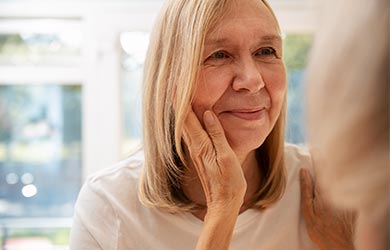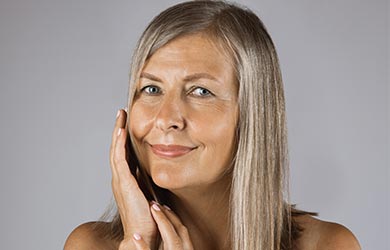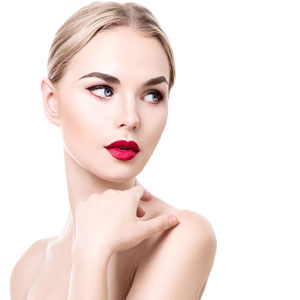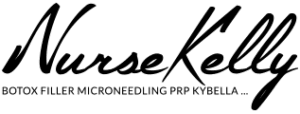
Conveniently located on Seven Mile Beach, Grand Cayman
WHAT IS ROSACEA?

Rosacea is a chronic skin condition characterized by facial redness, visible blood vessels, flushing, and acne-like bumps. It can lead to both cosmetic and health concerns, as the persistent redness and inflammation can affect an individual’s self-esteem and quality of life. In addition to the visible symptoms, this skin condition can cause discomfort, burning sensations, and stinging on the skin, making it challenging to manage. Furthermore, severe cases of rosacea may lead to unpleasant symptoms such as dryness, irritation, and inflammation of the eyes, potentially impacting vision and eye health.
CAUSES OF ROSACEA
The exact cause of rosacea remains unknown, but several factors are believed to contribute to its development. These include:
- Abnormalities in the immune system: Dysfunction in the immune system may play a role in triggering inflammation and vasodilation (widening of the blood vessels) in the skin.
- Blood vessel abnormalities: Abnormalities in the blood vessels of the skin, such as vasodilation and increased permeability (compromised skin barrier function), may contribute to flushing and redness.
- Demodex mites: These microscopic organisms that naturally inhabit the skin may multiply in higher numbers in individuals with rosacea, potentially contributing to inflammation and skin irritation.
- Environmental triggers: Certain environmental factors can exacerbate symptoms, including sun exposure, extreme temperatures, wind, humidity, and pollution.
- Genetics: Individuals with a family history of the condition are more likely to develop it.
- Microorganisms: Bacteria, particularly Helicobacter pylori and certain species of the Demodex mite, have been implicated in the development of the condition.
- Neurovascular dysregulation: Dysfunction in the nervous system’s control of blood flow to the skin may contribute to flushing and persistent skin redness.
While these factors are thought to contribute to the development of rosacea, the condition is likely multifactorial, with interactions between genetic predisposition, environmental triggers, and immune system abnormalities playing a complex role. Nurse Kelly considers these factors carefully during her assessments of patients affected by the skin condition, as understanding the underlying causes helps in tailoring personalized management strategies and treatment approaches. By addressing the specific triggers and predisposing factors unique to each patient, Nurse Kelly can develop effective plans to manage the symptoms and improve skin health.
RISK FACTORS FOR ROSACEA
Several risk factors can increase the likelihood of developing rosacea, including:
- Age (between the ages of 30 and 50)
- Certain medications (corticosteroids and drugs that widen blood vessels)
- Diet (consumption of alcohol, spicy foods, and hot beverages)
- Exposure to sunlight, heat, cold, wind, humidity, and pollution
- Fair skin
- Gender (more prevalent in women, while men often experience more severe symptoms)
- Genetics
- Stress
- Underlying health conditions (gastrointestinal disorders, autoimmune diseases, and hormonal imbalances)
- Use of harsh skincare products, abrasive exfoliants, and alcohol-based toners
Genesis Skin Treatment
Genesis skin treatment utilizes non-invasive laser technology to heat the deeper layers of the skin, stimulating collagen production and reducing inflammation. This helps to strengthen the skin’s natural defence mechanisms, minimizing redness, flushing, and the appearance of visible blood vessels associated with rosacea. In addition, Genesis skin treatment enhances microcirculation, promoting oxygenation and nutrient delivery to the skin, which can help alleviate discomfort and promote healing.
ZO Skin Health Facial Treatments
ZO Skin Health facial treatments, developed by Dr. Zein Obagi, focus on optimizing skin health and function through a combination of advanced skincare formulations and in-office procedures. These treatments incorporate ingredients such as retinoids, antioxidants, and growth factors to address inflammation, support skin barrier function, and promote collagen production. By restoring balance to the skin microbiome and providing essential nutrients, ZO facial treatments help calm inflammation, reduce redness, and improve the overall appearance of the skin.
PERSONALIZED MEDICAL ASSESSMENTS AND TREATMENT PLANS

Nurse Kelly approaches personalized medical assessments and treatment plans for rosacea with a comprehensive understanding of the condition’s multifaceted nature. During the initial assessment, Nurse Kelly conducts a thorough examination of the patient’s skin, considering factors such as the severity of redness, the presence of visible blood vessels, the occurrence of flushing episodes, and any associated symptoms such as burning or stinging sensations. In addition, Nurse Kelly takes into account the patient’s medical history, including any predisposing factors or triggers that may exacerbate rosacea symptoms, such as sun exposure, environmental factors, diet, and skincare habits. By gathering detailed information, Nurse Kelly can tailor the assessment to the patient’s unique needs and characteristics.
LINKS TO TREATMENT OPTIONS

GENESIS SKIN TREATMENTS |
Genesis skin treatment is a laser therapy that improves skin tone and reduces signs of aging through collagen stimulation. |

ZO FACIAL TREATMENTS |
ZO facial treatments are a range of professional skincare treatments designed to improve skin health and address various skin concerns. |
TREATMENT OPTIONS FOR ACNE & BLEMISHES
CHEMICAL PEELS
They are a chemical solution applied to the skin which causes controlled damage to the top skin layers. Chemical peels, such as ZO Peel, stimulate the body’s natural healing process – new skin cells form in the treated area and the old and dead skin cells slough off. This prompts the skin to exfoliate and peel off. Depending on the skin condition, the chemical solution to be used can vary – alpha hydroxy acids (AHAs), beta hydroxy acids (BHAs), or trichloroacetic acid (TCA). These acids can help address acne as well as blemishes by stimulating collagen production, unclogging skin pores, reducing inflammation, and dissolving dead skin cells in the treated area.
GENESIS SKIN TREATMENT
Genesis skin, treatment utilizes non-invasive laser technology, specifically the Nd:YAG laser. With this state-of-the-art treatment, it can target the deeper skin layers without causing damage to the surrounding tissue. The laser energy heats different skin layers in a controlled manner, which in turn stimulates collagen production. With increased collagen, enlarged pores shrink and skin inflammation is reduced. Moreover, the laser energy may also target blood vessels to reduce redness associated with acne.
MESOTHERAPY
Mesotherapy treatment with Pluryal, involves the injection of a customized cocktail of vitamins, minerals, amino acids, and other therapeutic ingredients directly into the middle layer of the skin known as the mesoderm. These ingredients stimulate collagen production and promote skin healing. Over time, the appearance and health of the skin is improved.
MICRODERMABRASION
Microdermabrasion with Dermasweep, makes use of a handheld device with a diamond-tipped or crystal-tipped abrasive surface to gently exfoliate the skin. During the treatment, the device is moved across the target area. This process helps to unclog pores and promote cell turnover (formation of new skin cells). As a result, the appearance of visible skin concerns are reduced. In addition, the treatment can also enhance the penetration of skincare products – this means better absorption of substances or ingredients which leads to increased efficacy.
MICRONEEDLING
Microneedling treatment uses Dermapen, a device with fine needles, to create controlled micro-injuries (very tiny wounds) on the skin’s surface. As a result, the body responds by activating the natural wound healing process (skin regeneration and remodeling). In addition, collagen production is increased and new, healthy skin cells form in the treated area. This process significantly reduces acne and blemishes and improves overall skin health.
ZO FACIAL TREATMENTS
ZO facial treatments, utilize a combination of advanced skincare techniques and medical-grade products. These treatments typically involve a series of steps, including cleansing, exfoliation, extraction (if necessary), and application of targeted serums or masks. This combination unclogs skin pores, reduces inflammation, and promotes skin renewal (new, healthy skin cells form in the treated area).
Fast Facts
Who’s it for?
Coolsculpting is indicated for patients with stubborn fat, cellulite, and double chin.
Similar products:
CoolTech, Clatuu.
Celebs who swear by it:
Jennifer Aniston, Kris Jenner, Mariah Carey and Kim Kardashian
Question & Answer
Are there discomforts associated with Coolsculpting?
During the procedure, you may feel sensations of deep pulling, tugging, and pinching as the applicator passes over the treated area. You may also experience cramping, stinging, or tingling sensations. As the freezing applicator delivers controlled cooling, the treated area will temporarily become numb, thus reducing any discomfort.
Will the fat come back after Coolsculpting?
The treatment permanently eliminates the fat cells in the treated area. However, you will still need to maintain a healthy weight after the treatment because significant weight gain can compromise your results.
How long does it take to see Coolsculpting results?
You may begin to notice the results 1 to 3 months after the treatment. However, you will need to wait 4 months to see the final results.
How many Coolsculpting treatments will I need?
The treatment permanently destroys approximately 25% of the exposed fat cells in the treated area but this is enough to produce significant body contouring improvement. While you may benefit from one treatment, you may need two treatment sessions to achieve the best results. The number of treatments you will need will depend on the amount of fat in the target area.
Are there any side effects associated with Coolsculpting?
After the treatment, you may experience mild discomforts such as redness, bruising, numbness, or swelling. You may apply ice packs to the treated area to minimize any discomfort. After 1 to 2 weeks, these discomforts should resolve completely.
Will I lose weight with Coolsculpting?
It is important to keep in mind that the treatment is not a weight loss solution. While Coolsculpting contours the treated area by delivering controlled and precise cooling to the fat cells, you will still need to commit to a healthy lifestyle after the treatment because significant weight gain can compromise your results.
Who are the ideal candidates for Coolsculpting?
The treatment is compatible with all skin types and tones. As long as you are in good overall physical and mental health, the treatment is right for you. However, you are not an ideal candidate for the treatment if you have the following:
- A significant amount of fat in a body area
- Cold agglutinin disease (a red blood cell disorder)
- Cryoglobulinemia (the presence of abnormal proteins in the blood)
- Paroxysmal cold hemoglobulinuria (a rare blood disorder that attacks red blood cells)
- Unrealistic expectations
How much does Coolsculpting cost?
The total cost will depend on the following factors:
- The practitioner’s fee
- The fee of the clinic or medical facility
- The number of treatment sessions required
- The body area needing treatment
The treatment is cosmetic in nature. This means that the cost of the treatment may not be covered by your insurance. Before the procedure, it is best to consult with your health insurance provider for more information.
References
- Oh, C. H., Shim, J. S., Bae, K. I., & Chang, J. H. (2020). Clinical application of cryolipolysis in Asian patients for subcutaneous fat reduction and body contouring. Archives of plastic surgery, 47(1), 62–69. https://doi.org/10.5999/aps.2019.01305. Retrieved from https://www.ncbi.nlm.nih.gov/pmc/articles/PMC6976754/.
- McKeown, D. J., & Payne, J. (2021). Significant improvement in body contour with multiple cycles of CoolSculpting: Results of a prospective study. Dermatologic therapy, 34(2), e14850. https://doi.org/10.1111/dth.14850. Retrieved from https://www.ncbi.nlm.nih.gov/pmc/articles/PMC8047906/.
- Lim, T., Ding, S. W., Chua, C. H., & Moey, H. X. (2021). Enhancing the Appearance of the “Six-Pack” Muscles Using Cryolipolysis: A Safe and Effective Method. Plastic and reconstructive surgery, 148(4), 775–779. https://doi.org/10.1097/PRS.0000000000008320. Retrieved from https://pubmed.ncbi.nlm.nih.gov/34550933/.
- Putra, I. B., Jusuf, N. K., & Dewi, N. K. (2019). Utilisation of Cryolipolysis among Asians: A Review on Efficacy and Safety. Open access Macedonian journal of medical sciences, 7(9), 1548–1554. Retrieved from https://www.ncbi.nlm.nih.gov/pmc/articles/PMC6542401/.
- Few, J., Saltz, R., Beaty, M., Kelly, M., Movassaghi, K., Marcus, K. A., Sieber, D., Burns, A. J., & Sangha, S. (2020). Cryolipolysis: Clinical Best Practices and Other Nonclinical Considerations. Aesthetic surgery journal. Open forum, 2(2), ojaa010. https://doi.org/10.1093/asjof/ojaa010. Retrieved from https://www.ncbi.nlm.nih.gov/pmc/articles/PMC7671251/.
- Naeimi, M. et al. (2019) Treatment by cryolipolysis with radio-frequency and ultrasound cavitation combination is no more effective in improving indices of adiposity than radio-frequency and ultrasound cavitation alone, Translational Metabolic Syndrome Research. Elsevier. Retrieved from https://www.sciencedirect.com/science/article/pii/S2588930318300136.
- Suh, D. H., Park, J. H., Jung, H. K., Lee, S. J., Kim, H. J., & Ryu, H. J. (2018). Cryolipolysis for submental fat reduction in Asians. Journal of cosmetic and laser therapy : official publication of the European Society for Laser Dermatology, 20(1), 24–27. https://doi.org/10.1080/14764172.2017.1368564. Retrieved from https://pubmed.ncbi.nlm.nih.gov/28850270/.
- Rodopoulou, S., Gavala, M. I., & Keramidas, E. (2020). Three-dimensional Cryolipolysis for Submental and Lateral Neck Fat Reduction. Plastic and reconstructive surgery. Global open, 8(4), e2789. https://doi.org/10.1097/GOX.0000000000002789. Retrieved from https://pubmed.ncbi.nlm.nih.gov/32440449/.
- de Gusmão, P. R., Canella, C., de Gusmão, B. R., Filippo, A. A., & Filippo, G. R. (2020). Cryolipolysis for local fat reduction in adults from Brazil: A single-arm intervention study. Journal of cosmetic dermatology, 19(11), 2898–2905. https://doi.org/10.1111/jocd.13389. Retrieved from https://pubmed.ncbi.nlm.nih.gov/32281283/.




 HOW TO LOOK YOUR BEST
HOW TO LOOK YOUR BEST